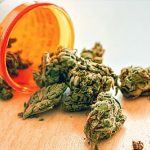 A mixture of the dried leaves, seeds, stems, and flowering tips of CANNABIS SATIVA. The active intoxicating ingredient is delta-9-tetrahydrocannabinol (THC). Marijuana may contain 0.1%–10% THC. The drug is smoked or ingested and produces euphoria, altered perceptions, memory impairment, and impaired psychomotor performance.
A mixture of the dried leaves, seeds, stems, and flowering tips of CANNABIS SATIVA. The active intoxicating ingredient is delta-9-tetrahydrocannabinol (THC). Marijuana may contain 0.1%–10% THC. The drug is smoked or ingested and produces euphoria, altered perceptions, memory impairment, and impaired psychomotor performance.
Dried leaves and flowers of Cannabis sativa which induces somatic and psychic changes when smoked or ingested in sufficient quantity.
A psychoactive drug, the active ingredient of which is delta 9-tetrahydrocannabinol (THC). THC was first synthesized in 1966. The marijuana plant is Cannabis sativa or Cannabis indica. It is metabolized in the liver and produces a feeling of stimulation, well-being, and tranquility. It may also produce feelings of hilarity or a desire for contemplative silence may be either smoked or eaten.
Drug produced from the leaves and flowers of the cannabis plant.
Drug, made from dried leaves of the Cannabis saliva plant, which, when smoked, provides a sense of euphoria often accompanied by changes in mood, perception, memory, and fine motor skills. The drug has been used to help relieve the nausea associated with cancer chemotherapy. Street names include pot, grass, and weed.
The dried flowering tops of Cannabis sativa, the hemp plant.
Marijuana (sometimes called pot or grass) is a psychoactive drug (i.e., mind- affecting) made from the leaves and flowers of the cannabis sativa plant. The principal psychoactive ingredient is delta-9-tetrahydrocannabinol (THC).
The dried flowers and leaves of the plant Cannabis saliva that are smoked or mixed in food and eaten for intoxicating effects.
An illegal psychoactive drug made from parts of the Indian hemp plant; it is one of the most frequently abused psychoactive drugs.
The blossoming upper parts and dehydrated leaves of the Indian hemp plant, Cannabis Sativa, encompassing the active compound THC (tetra-hydrocannabinol). These leaves are commonly smoked, but they can also be infused as tea or consumed as an ingredient in food.
Marijuana brings about physical effects such as dry mouth, minor eye redness, slight lack of coordination, and an augmented appetite. The predominant emotional experiences are often sensations of tranquility and contentment, although occasional episodes of depression can arise.
Elevated amounts can induce panic, a fear of mortality, and delusional states. In exceptional instances, drug-induced psychosis can manifest, marked by symptoms like paranoid delusions and confusion. Typically, these symptoms resolve within a few days.
Mounting evidence suggests that consistent marijuana consumption can exacerbate mental health issues, particularly depression and schizophrenia, particularly in those already grappling with these conditions. Adolescents are particularly vulnerable to these risks. Furthermore, habitual marijuana smoking might lead to more severe lung impairment compared to tobacco; it’s believed that the impact of three joints (marijuana cigarettes) is akin to that of 20 tobacco cigarettes.
